
|
||||||
|
THE GOLDEN ROSARY OF THE KAGYU Reviewing the lives of our lineage ancestors, by In the beginning, the land we know today as Tibet was not a united country, but a collection of petty kingdoms ruled by disparate local chieftans. The first recorded king was Nyatri Tsenpo », who appeared in the 4th century BC -- according to some stories as a wanderer from India, according to others, having descended from the heavens on a rope ladder. But it was not until the reign of Lha Thotori Nyentsen in the third century AD -- 233 AD, to be exact -- that we encounter the first suggestion of Buddhism entering Tibet. For it was then that a set of Buddhist objects known as “The Secret Antidotes” was said to have been found on the roof of the king's palace, having supposedly been blown there by a wind which carried them from the roof of an Indian king's residence. This collection included a silver stupa, a royal seal, and several religious scriptures written in an Indian dialect. Another, less exalted version of the tale suggests that these objects were in fact brought to Tibet by a Nepalese translator/scholar. Either way, as written Tibetan was at that time rudimentary, it was not possible to translate and record the texts then and there. Rather, as one prediction had it, they would be deciphered by one of the king's descendants within five generations. Still, Lha Thotori is traditionally credited with introducing the Dharma to Tibet, and indeed so paramount was the arrival of the sacred objects considered that the dating system for all Tibetan currency until the Communist Chinese invasion was based on the designation of 233 AD as Year One. It was indeed five generations later, with the appearance of King Songtsen Gampo », that the Dharma gained a solid foothold in Tibet. To understand the pre-eminent place held by this ruler we must understand the mystic bond that has existed primordially between the Tibetan people and the Bodhisattva of Boundless Compassion, Avalokiteshvara (Tib: Chenrezig). This bond has proven inalienable, even after the past fifty years of Communist occupation. Indeed, one version of Tibetan pre-history states that Avalokiteshvara had such compassion that he emanated in the land of Tibet as a monkey who, by uniting with a lustful rock ogress, was able not only to ease her karmic sufferings, but become, with her, the progenitor of the Tibetan people. It is therefore not hard to see why, retrospectively, the Tibetans look upon their seventh century ruler, Songtsen Gampo, as another emanation of Chenrezig, for he was the most active propagator of the Dharma to have appeared to that date. He achieved this mission in several ways: first, he sent one of his chief ministers, Thonmi Sambhota, along with a number of scholar students, to India to study the art of writing. With the help of Kashmiri pandits the group learned a dialect from which they devised the Tibetan alphabet. Thereafter, it was only a matter of time before Indian Dharma texts were being translated into Tibetan as rapidly as scholars could churn them out. This endeavor was to prove inestimably valuable, not only to Tibetans but to Indians as well,for soon the Muslim invasion would see the destruction of many sacred Buddhist texts in the land of their origin. Second, Songtsen's choice of wives also helped the Dharma flourish. Just as the king was considered an emanation of the Bodhisattva of Compassion, so were his principal wives -- one Nepalese, the other Chinese -- seen as emanations of the goddess Tara,Chenrezig's female counterpart. Further, each brought with her as part of her dowry a Buddha image having the power to transform the energy and karma not only of the area where it was placed and the people living there, but of the entire planet. Finally, Songtsen made his people abide by the Dharma, among other things holding them to the laws of the ten virtuous actions. He also hid many treasures of both a material and Dharmic nature, thus enriching the land and -- allegedly -- protecting it against foreign invasion. Lest it be thought, however, that Songtsen Gampo manifested only kindness and compassion, it is also a fact that he had a significant shadow side. For this king was definitely expansionist, and indeed Tibet under his rule was considered a rogue superpower. Its vast armies managed to overrun most of Asia, including India, Ladakh, Nepal, Sikkim, Bhutan and Burma. And when the Chinese emperor defaulted on what amounts to “protection money” (it took the form of a promised fifty thousand bolts of silk annually), 200,000 Tibetan troops occupied the Chinese capital of Chang'an -- no mean feat, for this city was at the time the largest in the world, and three times the size of Rome! These events put current Chinese-Tibet relations into something of a perspective. Is the occupation of Tibet perhaps a karmic kickback stemming from what happened centuries ago? Certainly, HH Dalai Lama has stated that Tibet's position today is attributable to karma -- whether because of Songtsen Gampo's actions or for other reasons it is impossible for ordinary beings to gauge. Whatever the case, Songtsen Gampo kept a firm grip on Tibet until his death at the age of 82, which event is recounted from two different perspectives: if one embraces a metaphoric view of history, one can accept the version stating that at the age of 82 the king sat, in company with his Nepalese and Chinese wives, in front of an eleven-faced statue of Avalokiteshvara into which he dissolved. A more prosaic version suggests that Songtsen, while out one day hunting yak, died after drinking very cold water on top of a bountiful meal. Whether the meat was tainted or the cold water proved too great a shock for the king's system is anyone's guess, but we do know that his reign came to an end around 650 AD. According to the 14th century text, The Clear Mirror on Royal Genealogy, the king's last words to his people were: “Reject mundane actions and practice the holy Dharma. Ponder impermanence and death, and generate diligence. You and I are inseparable and will always be together.” Here it is worthwhile to pause for a moment and consider how to reconcile the metaphoric vs. the historic interpretations of long-ago events, for in reviewing the history of our Dharma forefathers we will encounter seeming disparities again and again. Rita M. Gross, an author and retired professor of religious studies, perhaps resolved this issue best in an article appearing in Tricycle magazine (Summer/2012): “Religious stories do not have to be empirical history to have spiritual value,” she explains. “ One of our most urgent tasks as modern Dharma practitioners is to learn how to take traditional stories seriously without taking them literally.” In other words, is something true because it is provable, or because people believe in it? To Professor Gross and this writer it seems that there is room for two, seemingly conflicting points of view. After all, if we examine our own actions we can often tease apart what they may look like at an objective and practical level from the motivation actually driving them. Similarly, it is possible that Songtsen Gampo, while dying of perfectly prosaic causes, nonetheless had so keen a commitment to Buddhadharma that he was able to dissolve his consciousness -- whether out in a forest, or inside his palace shrine -- into the mind of Chenrezig ... who was none other than the king's own Buddha nature. Whatever the truth, it is certain that this Dharma king's story has inspired Tibetans throughout the centuries, and on that basis a whole culture moved in the direction of enlightenment. Later Dharma Kings Five generations after Songtsen Gampo, in the 8th century, Trisong Deutsen » came to power. In keeping with their view of their kings as Bodhisattva incarnations, Tibetans considered Trisong as Manjushri (Bodhisattva of Boundless Wisdom) embodied. Certainly his reign marked a kind of golden age in Tibet, not only spiritually but culturally as well. Strict legal codes were enacted for farmers and nomads, while physicians were invited from India, China, Persia and Nepal to compare and integrate key findings from each of their medical traditions. Under Trisong's rule the Dharma became yet more deeply embedded into the national psyche. Not only did scholars continue their translations apace, but the king invited the famed Abbot Shantarakshita from India to help establish Tibet's first Buddhist monastery, Samye », which still stands today, was laid out like the mandala of the universe as presented in Buddhist cosmology, complete with a large temple in the center representing Mt. Meru, surrounded by lesser temples symbolizing the four continents and eight subcontinents. When the building process was obstructed by (according to the Buddhist view) demons opposing the Dharma, Padmasambhava », the supreme Tantric practitioner known for taming intractable spirits, was called in from the kingdom of Swat to suppress them. Once completed, Samye served as home to Tibet's first ordained monks, known as the “Seven Trial Men.” By the time, a century later, that the next major ruler, Tri Ralpachen », came to power, Buddhism had so eclipsed the old, indigenous and animistic religion of Bon that Bon proponents felt seriously threatened -- not only from a religious point of view, but more to the point from a political and practical one. It has become the fashion amongst modern historians to disparage these Bon practitioners of old, but a closer look at conditions prevailing in the 8th and 9th centuries elicits sympathy. First, Buddhist translators were so highly prized that they received pay equal to that of the chief ministers -- a fact which did nothing to endear the former to the latter! Further, immense monetary and other privileges were accorded the burgeoning monasteries, whose vast land holdings were exempt from taxation, and whose members were released from military obligations. Moreover, the growing number of ordained of both sexes threatened to result in a marked population decline. Finally, beginning in the reign of Tri Ralpachen, monks were allowed to hold the highest government offices, at times lording their privileged status over that of the lay ministers. Besides the animosities these circumstances naturally gave rise to, Buddhism's pacifist stance signaled to Bonists the beginning of the end of the Tibetan empire. And given the events of the last fifty years, it can be seen that their concerns had a legitimate basis. Having reached their breaking point, leaders of the Bon hatched a plot in the year 841 to murder Tri Ralpachen. This they accomplished by strangling him while he was in a stupor resulting from excessive intake of rice beer! Ralpachen was succeeded by his brother, Lang Darma, whom Buddhists have long accorded a status similar to that of Chairman Mao, accusing him of the worst depredations including the destruction of monasteries and the persecution of the ordained. More recently, however, historians are inclined to take this calumny with a grain of salt, noting that it was not recorded in the annals of Lang Darma's time, but rather was written up about two centuries after the fact by biased Buddhist monks. The singularly valuable repository of texts found in the Dunhuang Caves of China reveals that Lang Darma actually was and remained a Buddhist and, contrary to later reports, did not destroy temples wholesale, but in fact built new ones and repaired the old. Simply, he wanted to withdraw some of the monk's privileges so as to strengthen Tibet's government both fiscally and militarily. Wherever the truth may lie, the fact is that a disciple of Padmasambhava, one Lhalung Palgyi Dorje », murdered Lang Darma by shooting him with an arrow at close range in the year 842. As clever as he was devout, Lhalung went to the fatal assignation wearing a black, reversible cloak with a white lining, and riding a white horse he had daubed with soot. As soon as the deed was committed, he reversed the cloak and rode his horse through a river so that the animal emerged white! Racing to his meditation cave, he scattered dust on the sill so it would appear that no one had crossed the threshold for some while. Eventually, he escaped to Kham. Lang Darma's death marked the end of that royal dynasty, while whatever family members remaining decided to travel in diverse directions, one branch settling in Western Tibet and establishing the kingdom of Guge. We will focus on this western sector of the kingdom presently, but first it must be noted that over the next few centuries the Dharma declined significantly. In part, this was due to the jaundiced eye with which the Bonists looked upon the Buddhist sangha during the reign of Lang Darma, and in part because the Tantric teachings of Padmasambhava had over time been so misappropriated that by mid-eleventh century they had fallen into near-total degeneration. It was at this critical moment that a valiant king of Western Tibet, Yeshe Od, determined to restore the Dharma to its original pristine state. However, before he could undertake this mission he was captured by a Muslim Turkic army that demanded a ransom equal to the king's body weight. Yeshe Od's nephew, Jangchub Od, scrambled to gather the necessary gold, but was only able to amass the weight of the king's body minus his head. When he asked his uncle what to do, Yeshe Od replied that as his life span was already well advanced, it was not worth prolonging, but instead to offer what gold had been collected to To gain some notion of who Lama Atisha ». The latter was then residing at Vikramashila monastery in India, had been a student of Mahapandita Naropa, and was renowned for the superiority of his scholarship, his debating skills, and his meticulousness in following even the least of the Vinaya (vows for monks and nuns). As it happened, coincident with the arrival of Jangchub Od's emissaries inviting him to Tibet, Atisha had a dream in which the goddess Tara told him he should go to Tibet to work for the benefit of beings there. This, plus the realization that Yeshe Od had sacrificed his life in order to make his trip possible moved Atisha to accept the invitation-- despite the fact that a dakini informed him that though he would score a great success in Tibet, the rigors of the terrain there would take 20 years off his life. Believing in his mission, Atisha, indifferent to worldly goods, returned the gold, wrapped up his tasks at Vikramashila, and departed for Tibet in the year 1040. Once arrived, he righted what had become deviant interpretations of Tantra, built monasteries and shrines, and gave proof of his miracle powers, being seen, among other feats, to circumambulate Samye from the distance of a man's height above the ground. In sum,Atisha initiated what is known as “the second propagation of the Dharma in Tibet,” the first, of course, having begun with the arrival of Padmasambhava. This was the fortunate position in which the Dharma in Tibet found itself at the moment when we return to our Kagyu lineage forefathers, beginning with Lord Marpa who, like Atisha, became a student of the Indian Mahapandita Naropa. *
Further information on the Dharma Kings, Lang Darma and Atisha may be found in the following texts: A History of the Tibetan Empire, by HH the Drikung Kyabgon, Chetsang Rinpoche(Songtsen Library, Dehra Dun, India) Ancient Tibet (Dharma Publishing) The Clear Mirror, by Sakyapa Sonam Gyaltsen (Snow Lion) The Arrow and the Spindle, by Samten G. Karmay (Mandala Publications) Atisha and Tibet, by Alaka Chattopadhyaya (Motilal Bandarsidass Publishers, Delhi) |
|||||
© 2002 Junipur Press ALL RIGHTS RESERVED. Please contact us for permission if your wish to reproduce any material found on this site, including text, pictures and code.
 In the beginning, the land we know today as Tibet was not a united country, but a collection of petty kingdoms ruled by disparate local chieftans. The first recorded king was Nyatri Tsenpo
In the beginning, the land we know today as Tibet was not a united country, but a collection of petty kingdoms ruled by disparate local chieftans. The first recorded king was Nyatri Tsenpo 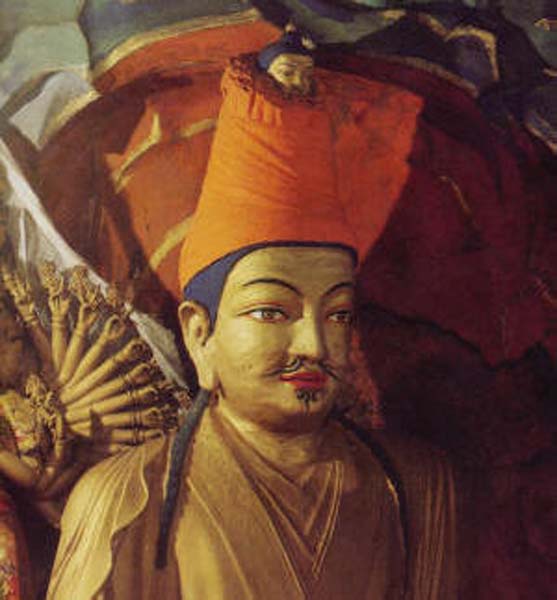 It was indeed five generations later, with the appearance of King Songtsen Gampo
It was indeed five generations later, with the appearance of King Songtsen Gampo  Five generations after Songtsen Gampo, in the 8th century, Trisong Deutsen
Five generations after Songtsen Gampo, in the 8th century, Trisong Deutsen 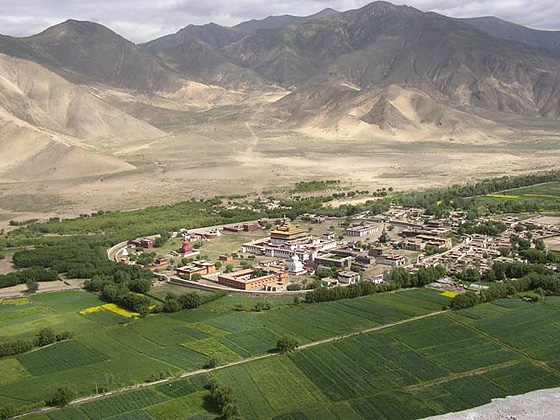
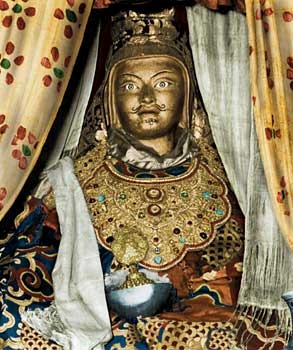 Under Trisong's rule the Dharma became yet more deeply embedded into the national psyche. Not only did scholars continue their translations apace, but the king invited the famed Abbot Shantarakshita from India to help establish Tibet's first Buddhist monastery, Samye
Under Trisong's rule the Dharma became yet more deeply embedded into the national psyche. Not only did scholars continue their translations apace, but the king invited the famed Abbot Shantarakshita from India to help establish Tibet's first Buddhist monastery, Samye 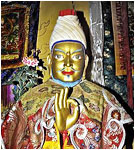 By the time, a century later, that the next major ruler, Tri Ralpachen
By the time, a century later, that the next major ruler, Tri Ralpachen 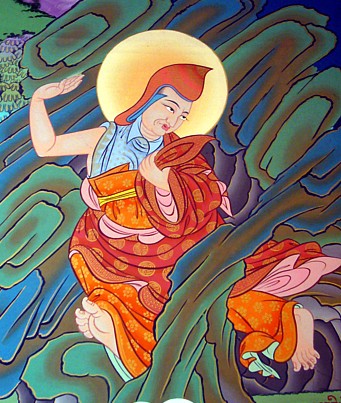 Wherever the truth may lie, the fact is that a disciple of Padmasambhava, one Lhalung Palgyi Dorje
Wherever the truth may lie, the fact is that a disciple of Padmasambhava, one Lhalung Palgyi Dorje 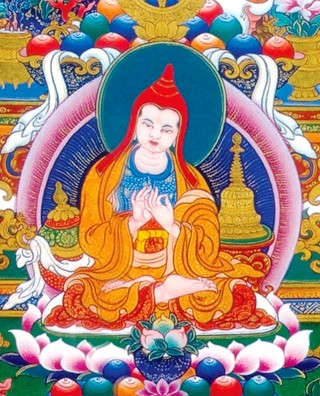 To gain some notion of who Lama Atisha
To gain some notion of who Lama Atisha